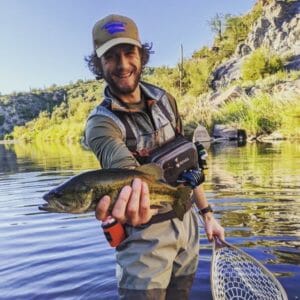
In this series, we’re sitting down with the Swette Center affiliated faculty to catch up on food systems, innovation, and what makes a good meal. See the rest of the series on our Food Systems Profiles page.
Read on for an interview with Bryan Leonard, Senior Global Futures Scientist in the Julie Ann Wrigley Global Futures Laboratory; Assistant Professor in the School of Sustainability, College of Global Futures.
How did you get interested in food systems issues?
My interest stems from my passion for property rights to land and water, which are critical inputs to most food systems. I think through how to define rights to land and water in order to produce food effectively, given the many competing uses for land and water.
Share a glimpse of your current research and how it applies to food systems transformation.
One thing I’m currently working on is the restoration of indigenous water rights in the American West. Tribes didn’t get water rights when we were allocating water in the 19th century in the US, but thanks to a 1908 Supreme Court ruling, there is a legal pathway for indigenous tribes to get water rights back. There is a whole political process of getting water rights for tribes, determining how much water they will get, and what they can do with that water. There are many estimates that suggest that as much as a third of the annual flow of the Colorado River could end up going solely to tribes. Most of these negotiations are really focused on putting the water to use for agriculture on reservations. I’ve been doing some work looking at what actually happens when tribes get water rights. About 26 reservations have gotten water rights so far, and I’ve been studying the changes in land and water use on reservations after they get a water right. I have found that there is only a 5% increase in agriculture, which is quite small. So despite the fact that tribes have rights to water and could use them to grow food in theory, what’s actually happening is that people who were previously using the water off the reservation are continuing to use it. This creates some big questions about what the future of water use and agricultural production in the American West will look like if tribes start using their water rights.
What’s an innovation in the food systems world that you’re excited about?
I’m really excited about the ability to use satellite data to measure water use. Water in the western US is very scarce and there are a lot of research questions about how farmers use water, how they respond to changes in prices, and how they respond to weather shocks. Water use in agriculture has always been hard to measure because there is no centralized way of collecting that information and there isn’t a great system of measurement for who is diverting how much water and when, and how much of that water is consumptively used. There are a lot of things we could better understand if we could measure water use. In the last decade, remote sensors have gotten really good at using satellite data combined with basic modelling to read satellite images and get an estimate of the consumptive use of water in a given area. Basically, it takes a reading of surface moisture, color, and other variables to estimate water use from the sky. A new project called OpenET just launched within the last month and made field-level ET (evapotranspiration) estimates available across the western US going back to 2016. Suddenly, there is a lot of data about water use that we can use for measurements. I find this incredibly exciting. I think it will be very useful for policy too. Irrigation districts, state water managers, and individual farmers can plan much more precisely because they can measure how much water they’re using. They can also understand the impacts of climate change in a much more sophisticated way than what would have been possible even 5 or 10 years ago.
What’s your go-to weeknight meal?
It would probably be pasta. It’s easy, delicious, and quick. I really like a good pesto-based sauce.